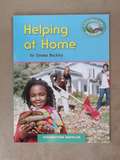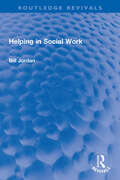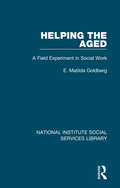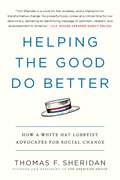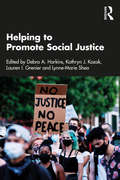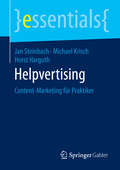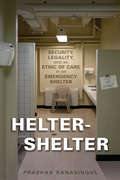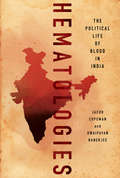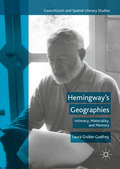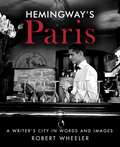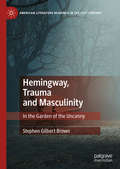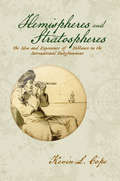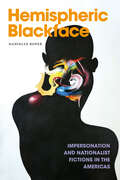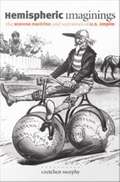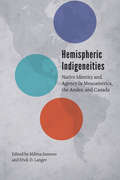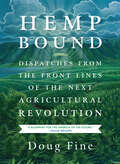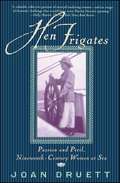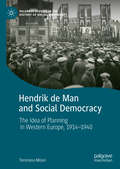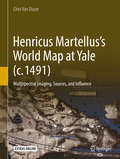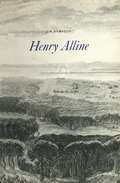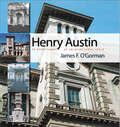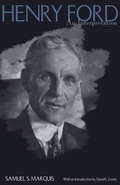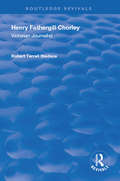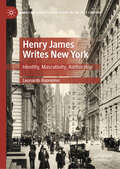- Table View
- List View
Helping at Home (Houghton Mifflin Vocabulary Reader Accompanies Journeys)
by Emma BuckleyNIMAC-sourced textbook <P><P>Level E DRA 8 Social Studies Strategy
Helping in Social Work (Routledge Revivals)
by Bill JordanFirst published in 1979, Helping in Social Work elaborates on the personal processes of influence in social work between clients and social workers. Shifting focus from the organizational structure of social work to face-to-face interactions, the author expounds on the personal and qualitative components in social work. The aim of this book is to present a simple, practical and positive account of the elements that make up good practice in the sort of work which statutory social workers do, without relying on excessive jargon. These experiences of helping and being helped will be of importance to students of social work and social policy as well as any reader trying to gain an insight into the everyday realities of social workers.
Helping the Aged: A Field Experiment in Social Work (National Institute Social Services Library)
by E. Matilda GoldbergIn 1970 social workers were in great demand and their numbers were growing. At the same time questions were asked on both sides of the Atlantic about the methods they employed, their objectives and the effectiveness of their efforts. Previous studies undertaken in the United States to test the effectiveness of social casework had led to intense controversy between researchers and practitioners. Originally published in 1970, the field experiment described in this book was the first British attempt to assess the effectiveness of social work. A team led by a social worker, including a physician and a statistician, assessed the social and medical conditions of 300 aged applicants to a local authority welfare department and determined their needs for help. Half of these old people were randomly selected to receive help from trained caseworkers; the other half, also randomly chosen, remained with experienced local authority welfare officers without professional training. The social and medical conditions of the surviving clients were reassessed after an interval. Both sets of social workers had achieved much in alleviating practical needs. But the trained workers brought about more change in their clients’ activities, feelings and attitudes. The opinions of the old people about the services they received and the social workers who had carried them out added another dimension to this pioneer study which contributed to research methodology, helped to clarify operational goals in social work, made a beginning in measuring social work effort and enlarged our meagre knowledge of social work with old people at the time.
Helping the Good Do Better: How a White Hat Lobbyist Advocates for Social Change
by Thomas F. SheridanHow to effect positive social change by the top progressive white hat lobbyist in Washington.HELPING THE GOOD DO BETTER pulls back the curtain on the corridors of power in Washington to reveal how social change really happens. This book offers lessons from the trenches on how some of this generation's most defining social issues-AIDS, disabilities, global poverty, cancer, human trafficking, national service, early childhood education, and social entrepreneurship -- engendered landmark federal policies. Each chapter tells the story of how a particular issue was shaped by the movements and legislation at the center of public debate. Each case provides powerful lessons about how coalitions are built, strategies crafted, and powerful interests challenged in high-stakes, no-holds-barred political battles.Doing good requires more than just providing programs and services. It requires coordination, organization, and a new, stronger emphasis on and dedication to advocacy. Participating in advocacy is no longer a luxury -- it is a necessity. Visionaries and activists together with "white hat" lobbyists -- people who understand the power of politics and who are able to put it to work to serve the public interest -- have won some of the most transformative policy fights in recent times. The culmination of those experiences, of fighting and winning on behalf of public interest causes, is presented here in a new theory for social change. Successful campaigns and movements must possess a lobbyist's combined approach to policy, politics, and press. Leveraging these 3 Ps, with true passion and discipline, can create results that are nothing short of awe-inspiring.An insightful first-person guide to advocacy by a white-hat lobbyist who was in the rooms where historic social changes were made, HELPING THE GOOD DO BETTER is a direct and honest look at government in action and the behind-the-scenes players who help make progress a reality. p.p1 {margin: 0.0px 0.0px 0.0px 0.0px; text-align: justify; line-height: 12.1px; font: 13.0px Times} p.p2 {margin: 0.0px 0.0px 0.0px 0.0px; text-align: justify; line-height: 12.1px; font: 13.0px Times; min-height: 16.0px} p.p3 {margin: 0.0px 0.0px 0.0px 0.0px; text-align: justify; line-height: 10.1px; font: 13.0px Times; min-height: 16.0px} p.p4 {margin: 0.0px 0.0px 0.0px 0.0px; text-align: justify; line-height: 10.1px; font: 13.0px Times}
Helping to Promote Social Justice
by Debra A. Harkins; Kathryn J. Kozak; Lauren I. Grenier; Lynne-Marie SheaHelping to Promote Social Justice is a richly informed and practical guide for advanced students and young professionals to become helpers capable of promoting social justice with whomever they collaborate with, mentor, serve and consult. Filled with insight and supplemental exercises, the book will direct readers to think critically and reflect on the broader social and political systems that create our current social injustices. Beginning with a strong theoretical focus on power, social identity and intersectionality, the authors engage with readers’ assumptions on helping, their value systems and their understandings of power and privilege when helping communities in need. The rest of the book focuses on the application of these critical concepts, guiding future helpers to consider how to intervene, assess need, lead, build a team, address conflict and work to promote change from a position of social justice. Written by academic faculty with expertise in teaching, coaching and consulting, Helping to Promote Social Justice should be considered essential reading for students in social work, psychology and counselling.
Helpvertising: Content-Marketing für Praktiker (essentials)
by Jan Steinbach Michael Krisch Horst HarguthJan Steinbach, Michael Krisch und Horst Harguth zeigen, dass es beim Content-Marketing weniger um die Unterbrechung durch Werbung, sondern vielmehr darum gehen sollte, hilfreiche Inhalte mit Mehrwert zu entwickeln. ,Helpvertising' stellt dar, wie Sie diese Form des Marketings erfolgreich in Ihrer Unternehmenspraxis einsetzen können. Unterbrechende Werbung soll dazu dienen, die Aufmerksamkeit auf die Produkte und Leistungen zu lenken und ein Kaufbedürfnis auszulösen. Diese Form des Marketings ist für Kunden nicht sonderlich attraktiv und für Unternehmen immer ineffizienter. Im digitalen Zeitalter wollen Menschen zunehmend selbst entscheiden, ob, wo, wann und wie sie mit Unternehmen interagieren. Daher benötigen wir im Marketing eine neue Denkweise. Die Autoren nennen diesen Ansatz Helpvertising.
Helter-Shelter: Security, Legality, and an Ethic of Care in an Emergency Shelter
by Prashan RanasingheHelter-Shelter is an ethnographic account of the manner in which an emergency shelter is governed on a daily basis, from the perspective of the personnel who are employed and tasked with providing care. Prashan Ranasinghe focuses on how the founding ethos of the shelter, an ethic of care, is conceptualized and practiced by examining its successes and failures. Ranasinghe reveals how this logic is diluted and adulterated because of two other important logics, security and legality, which, working alongside, take precedence and trump the import of care. The care that is deployed is heavily legalized and securitized and it is also administered inconsistently and idiosyncratically. As a result, disorder and confusion pervade the shelter. Helter-Shelter offers a unique perspective on the delivery of care, and how this laudable intention faces such daunting challenges.
Hematologies: The Political Life of Blood in India
by Jacob Copeman Dwaipayan BanerjeeIn this ground-breaking account of the political economy and cultural meaning of blood in contemporary India, Jacob Copeman and Dwaipayan Banerjee examine how the giving and receiving of blood has shaped social and political life. Hematologies traces how the substance congeals political ideologies, biomedical rationalities, and activist practices.Using examples from anti-colonial appeals to blood sacrifice as a political philosophy to contemporary portraits of political leaders drawn with blood, from the use of the substance by Bhopali children as a material of activism to biomedical anxieties and aporias about the excess and lack of donation, Hematologies broaches how political life in India has been shaped through the use of blood and through contestations about blood. As such, the authors offer new entryways into thinking about politics and economy through a "bloodscape of difference": different sovereignties; different proportionalities; and different temporalities. These entryways allow the authors to explore the relation between blood's utopic flows and political clottings as it moves through time and space, conjuring new kinds of social collectivities while reanimating older forms, and always in a reflexive relation to norms that guide its proper flow.
Hemingway's Geographies
by Laura Gruber GodfreyThis book draws on the tools of literary analysis and culturalgeography to investigate Ernest Hemingway's sophisticated construction ofphysical environments. In doing so, Laura Gruber Godfrey revises conventional approachesto Hemingway's literary landscapes and provides insight about his fictionalcharacters and his readers alike.
Hemingway's Paris: A Writer's City in Words and Images
by Robert WheelerWalk through the Streets of Paris with Ernest Hemingway. In gorgeous black and white images, Hemingway’s Paris depicts a story of remarkable passion--for a city, a woman, and a time. No other city in any of his travels was as significant, professionally or emotionally, as was Paris. And it remains there, all of the complexity, beauty, and intrigue that Hemingway described in the pages of so much of his work. It is all still there for the reader and traveler to experience--the history, the streets, and the city. Restaurants, hotels, homes, sites and favorite bars are all detailed here. The ninety-five black and white photographs in Hemingway’s Paris are of the highest caliber. The accompanying text reveals Wheeler’s deep understanding of the man; his torment, talent, obstacles and the places of refuge needed to nurture one of the preeminent writers of the twentieth century. Moved by the humanistic writing of the man--a writer capable of transcending his readers to foreign settings and into the hearts and minds of his protagonists--Wheeler was inspired to travel throughout France, Italy, Spain, Africa, and Cuba, where he has sought to gain insight into the motivation behind Hemingway’s books and short stories. As a teacher, lecturer, and photojournalist, he set out to capture and interpret the Paris that Ernest Hemingway experienced in the first part of the century. Through his journal and photographs, Wheeler portrays the intimate connection Hemingway had with the woman he never stopped loving, Hadley, and with the city he loved most, Paris.
Hemingway, Trauma and Masculinity: In the Garden of the Uncanny (American Literature Readings in the 21st Century)
by Stephen Gilbert BrownHemingway, Trauma and Masculinity: In the Garden of the Uncanny is at once a model of literary interpretation and a psycho-critical reading of Hemingway’s life and art. This book is a provocative and theoretically sophisticated inquiry into the traumatic origins of the creative impulse and the dynamics of identity formation in Hemingway. Building on a body of wound-theory scholarship, the book seeks to reconcile the tensions between opposing Hemingway camps, while moving beyond these rivalries into a broader analysis of the relationship between trauma, identity formation and art in Hemingway.
Hemispheres and Stratospheres: The Idea and Experience of Distance in the International Enlightenment (Transits: Literature, Thought & Culture 1650-1850)
by Rachel Mann Phyllis Thompson Kevin L. Cope Roger D. Lund William Stargard Bärbel Czennia Brijraj Singh Chandrava ChakravartyRecognizing distance as a central concern of the Enlightenment, this volume offers eight essays on distance in art and literature; on cultural transmission and exchange over distance; and on distance as a topic in science, a theme in literature, and a central issue in modern research methods. Through studies of landscape gardens, architecture, imaginary voyages, transcontinental philosophical exchange, and cosmological poetry, Hemispheres and Stratospheres unfurls the early history of a distance culture that influences our own era of global information exchange, long-haul flights, colossal skyscrapers, and space tourism. Published by Bucknell University Press. Distributed worldwide by Rutgers University Press.
Hemispheric Blackface: Impersonation and Nationalist Fictions in the Americas (Dissident Acts)
by Danielle RoperIn Hemispheric Blackface, Danielle Roper examines blackface performance and its relationship to twentieth- and twenty-first-century nationalist fictions of mestizaje, creole nationalism, and other versions of postracialism in the Americas. Challenging both the dominance of the US minstrel tradition and the focus on the nation in blackface studies, Roper maps a hemispheric network of racial impersonation in Peru, Bolivia, Colombia, Jamaica, Cuba, and Miami. She analyzes blackface performance in the aftermath of the turn to multiculturalism in Latin America, the emergence of modern blackness in Jamaica, and the rise of Barack Obama in the United States, showing how blackface remains embedded in cultural entertainment. Contending that the Americas are linked by repeating nationalist fictions of postracialism, colorblindness, and myths of racial democracy, Roper assesses how acts of impersonation mediate the ongoing power of these narratives and enable people to comprehend advancements and reversals in racial equality. Rather than simply framing blackface as liberatory or oppressive, Roper traces its emergence from a shared history of slavery and the varied politics of racial enjoyment throughout the hemisphere.
Hemispheric Imaginings: The Monroe Doctrine and Narratives of U.S. Empire
by Gretchen MurphyIn 1823, President James Monroe announced that the Western Hemisphere was closed to any future European colonization and that the United States would protect the Americas as a space destined for democracy. Over the next century, these ideas--which came to be known as the Monroe Doctrine--provided the framework through which Americans understood and articulated their military and diplomatic role in the world. Hemispheric Imaginings demonstrates that North Americans conceived and developed the Monroe Doctrine in relation to transatlantic literary narratives. Gretchen Murphy argues that fiction and journalism were crucial to popularizing and making sense of the Doctrine's contradictions, including the fact that it both drove and concealed U. S. imperialism. Presenting fiction and popular journalism as key arenas in which such inconsistencies were challenged or obscured, Murphy highlights the major role writers played in shaping conceptions of the U. S. empire. Murphy juxtaposes close readings of novels with analyses of nonfiction texts. From uncovering the literary inspirations for the Monroe Doctrine itself to tracing visions of hemispheric unity and transatlantic separation in novels by Lydia Maria Child, Nathaniel Hawthorne, Mara Amparo Ruiz de Burton, Lew Wallace, and Richard Harding Davis, she reveals the Doctrine's forgotten cultural history. In making a vital contribution to the effort to move American Studies beyond its limited focus on the United States, Murphy questions recent proposals to reframe the discipline in hemispheric terms. She warns that to do so risks replicating the Monroe Doctrine's proprietary claim to isolate the Americas from the rest of the world.
Hemispheric Indigeneities: Native Identity and Agency in Mesoamerica, the Andes, and Canada
by Erick D. Langer Miléna SantoroHemispheric Indigeneities is a critical anthology that brings together indigenous and nonindigenous scholars specializing in the Andes, Mesoamerica, and Canada. The overarching theme is the changing understanding of indigeneity from first contact to the contemporary period in three of the world’s major regions of indigenous peoples. Although the terms indio, indigène, and indian only exist (in Spanish, French, and English, respectively) because of European conquest and colonization, indigenous peoples have appropriated or changed this terminology in ways that reflect their shifting self-identifications and aspirations. As the essays in this volume demonstrate, this process constantly transformed the relation of Native peoples in the Americas to other peoples and the state. This volume’s presentation of various factors—geographical, temporal, and cross-cultural—provide illuminating contributions to the burgeoning field of hemispheric indigenous studies.Hemispheric Indigeneities explores indigenous agency and shows that what it means to be indigenous was and is mutable. It also demonstrates that self-identification evolves in response to the relationship between indigenous peoples and the state. The contributors analyze the conceptions of what indigeneity meant, means today, or could come to mean tomorrow.
Hemp Bound: Dispatches from the Front Lines of the Next Agricultural Revolution
by Doug Fine"Doug has created a blueprint for the America of the future.&”—Willie NelsonThe stat sheet on hemp sounds almost too good to be true: its fibers are among the planet&’s strongest, its seed oil the most nutritious, and its potential as an energy source vast and untapped. Its one downside? For nearly a century, it&’s been illegal to grow industrial cannabis in the United States–even though Betsy Ross wove the nation&’s first flag out of hemp fabric, Thomas Jefferson composed the Declaration of Independence on it, and colonists could pay their taxes with it. But as the prohibition on hemp&’s psychoactive cousin winds down, one of humanity&’s longest-utilized plants is about to be reincorporated into the American economy. Get ready for the newest billion-dollar industry.In Hemp Bound: Dispatches from the Front Lines of the Next Agricultural Revolution, bestselling author Doug Fine embarks on a humorous yet rigorous journey to meet the men and women who are testing, researching, and pioneering hemp&’s applications for the twenty-first century. From Denver, where Fine hitches a ride in a hemp-powered limo; to Asheville, North Carolina, where carbon-negative hempcrete-insulated houses are sparking a mini housing boom; to Manitoba where he raps his knuckles on the hood of a hemp tractor; and finally to the fields of east Colorado, where practical farmers are looking toward hemp to restore their agricultural economy—Fine learns how eminently possible it is for this misunderstood plant to help us end dependence on fossil fuels, heal farm soils damaged after a century of growing monocultures, and bring even more taxable revenue into the economy than its smokable relative.Fine&’s journey will not only leave you wondering why we ever stopped cultivating this miracle crop, it will fire you up to sow a field of it for yourself, for the nation&’s economy, and for the planet.
Hen Frigates: Passion and Peril, Nineteenth-century Women at Sea
by Joan DruettA "hen frigate," traditionally, was any ship with the captain's wife on board. Hen frigates were miniature worlds -- wildly colorful, romantic, and dangerous. Here are the dramatic, true stories of what the remarkable women on board these vessels encountered on their often amazing voyages: romantic moonlit nights on deck, debilitating seasickness, terrifying skirmishes with pirates, disease-bearing rats, and cockroaches as big as a man's slipper. And all of that while living with the constant fear of gales, hurricanes, typhoons, collisions, and fire at sea. Interweaving first-person accounts from letters and journals in and around the lyrical narrative of a sea journey, maritime historian Joan Druett brings life to these stories. We can almost feel for ourselves the fear, pain, anger, love, and heartbreak of these courageous women. Lavishly illustrated, this breathtaking book transports us to the golden age of sail.
Hendrik de Man and Social Democracy: The Idea of Planning in Western Europe, 1914–1940 (Palgrave Studies in the History of Social Movements)
by Tommaso MilaniThe book investigates the intellectual and political trajectory of the Belgian theorist Hendrik de Man (1885-1953) by examining the impact that his works and activism had on Western European social democracy between the two world wars. Based on multinational archival research, the book highlights how the idea of economic planning became part of a wider effort to address an ideological crisis within the socialist movement and revitalise the latter amidst the Great Depression. A heavily controversial figure also because of his subsequent involvement in Belgian wartime collaboration, de Man played a pivotal role in challenging traditional Marxist assumptions about the role of the state under capitalism and in promoting transnational exchanges between unorthodox social democrats across Europe. Starting from de Man’s experience in World War I, the book analyses his departure from Marxism, his elaboration of an alternative social democratic paradigm, his entry in Belgian politics as well as the reception of his thought in France and Britain.
Hengeworld
by Michael PittsIn November 1997 English Heritage announced the discovery of a vast prehistoric temple in Somerset. The extraordinary wooden rings at Stanton Drew are the most recent and biggest of a series of remarkable discoveries that have transformed the way archaeologists think of the great monuments in the region, including Avebury and Stonehenge; one of the world's most famous prehistoric monuments, top tourist site and top location for summer solstice celebrations. The results of these discoveries have not been published outside academic journals and no one has considered the wider implications of these finds. Here Mike Pitts, who has worked as an archaeologist at Avebury, and has access to the unpublished English Heritage files, asks what sort of people designed and built these extraordinary neolithic structures - the biggest in Britain until the arrival of medieval cathedrals. Using computer reconstructions he shows what they looked like and asks what they are for. This is the story of the discovery of a lost civilisation that spanned five centuries, a civilisation that now lies mostly beneath the fields of Southern England.
Henricus Martellus’s World Map at Yale: Multispectral Imaging, Sources, and Influence (c. #1491)
by Chet Van DuzerThis book presents groundbreaking new research on a fifteenth-century world map by Henricus Martellus, c. 1491, now at Yale. The importance of the map had long been suspected, but it was essentially unstudiable because the texts on it had faded to illegibility. Multispectral imaging of the map, performed with NEH support in 2014, rendered its texts legible for the first time, leading to renewed study of the map by the author. This volume provides transcriptions, translations, and commentary on the Latin texts on the map, particularly their sources, as well as the place names in several regions. This leads to a demonstration of a very close relationship between the Martellus map and Martin Waldseemüller’s famous map of 1507. One of the most exciting discoveries on the map is in the hinterlands of southern Africa. The information there comes from African sources; the map is thus a unique and supremely important document regarding African cartography in the fifteenth century. This book is essential reading for digital humanitarians and historians of cartography.
Henry Alline: 1748-1784
by J. M. BumstedTo Canadians of this century the name of Henry Alline is almost unknown. This biography introduces him to the general reader. Through the story of his life it also recreates the early settlement of the Maritime provinces, and examines the origins of one of the most dominant and continuing themes in Canadian life, evangelical pietism. Henry Alline emigrated from Rhode Island to Nova Scotia with his parents in 1760. Following his religious conversion during adolescence, he became an evangelical preacher and travelled throughout Nova Scotia spreading the gospel. But Alline was more than an itinerant preacher. Drawing on British (and indirectly on German) mythical writings, he rejected the tenets of Calvinism in favour of universal salvation and human free will. He emphasized Christian asceticism and mysticism. His writings, and his attempts to develop an intellectual rationale for his evangelical position, made him Canada's first metaphysical and mystical philosopher.In the history of early British settlement in Nova Scotia the name of Alline stands out because of his participation in the process and problems of settlement and his leadership during the trying times of the American Revolution. His career embodied a rejection of both the United States (by a rejection of Puritanism) and of Britain (by a rejection of church and state in Nova Scotia), and put Alline in a classic Nova Scotia position, neutrality, which could be justified by the importance of Christ and the relative unimportance of government. The years in which Alline lived were particularly critical ones for Canada, and his career both mirrors and dominates a period of pioneer hardships, political crises, and spiritual concern born of the uncertainties of human existence.
Henry Austin: In Every Variety of Architectural Style (Garnet)
by James F. O'GormanWinner of the Historic New England Book Prize (2009) Winner of the Henry-Russell Hitchcock Book Award (2010) Henry Austin's (1804–1891) works receive consideration in books on nineteenth-century architecture, yet no book has focused scholarly attention on his primary achievements in New Haven, Connecticut, in Portland, Maine, and elsewhere. Austin was most active during the antebellum era, designing exotic buildings that have captured the imaginations of many for decades. James F. O'Gorman deftly documents Austin's work during the 1840s and '50s, the time when Austin was most productive and creative, and for which a wealth of material exists. The book is organized according to various building types: domestic, ecclesiastic, public, and commercial. O'Gorman helps to clarify what buildings should be attributed to the architect and comments on the various styles that went into his eclectic designs. Henry Austin is lavishly illustrated with 132 illustrations, including 32 in full color. Three extensive appendices provide valuable information on Austin's books, drawings, and his office
Henry Ford: An Interpretation
by David L. Lewis Samuel S. MarquisA reprint of the rare and controversial biography of Henry Ford, first published in 1923, written by Ford's close associate.
Henry Fothergill Chorley: A Victorian Artist (Routledge Revivals)
by Robert Terrell BledsoeFirst published in 1998, this book focuses on the once celebrated but now neglected musical journalism of Henry Forthergill Chorley. For nearly forty years he effectively used his acerbic pen and idiosyncratic critical judgments to celebrate the works of Rossini, Mendelssohn, Meyerbeer, Gounod and Sullivan, and to scorn those of Schumann , Verdi and Wagner. This book also discusses his friendships with literary figures such as Charles Dickens, Elizabeth Barrett Browning, and Felicia Hemans, as well as his ongoing efforts to establish himself as a novelist as well as a journalist.
Henry James Writes New York: Identity, Masculinity, Authorship (American Literature Readings in the 21st Century)
by Leonardo BuonomoThis book offers the first full-length study of Henry James's relationship with, and literary treatment of, New York. It shows how the city, whether observed or reimagined, always remained an essential component of James's identity. New York compelled James to confront both his status as an American-born male artist and his age's prevailing notions of gender, sexuality, class, citizenship, and success. Tracing James's attachment to the city and how it evolved during his lifetime, this book examines a wide range of James's works, from his short stories and novels to his non-fiction writing.
